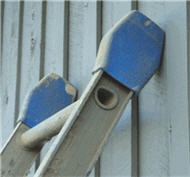
Exterior Painting Tips
For painters starting a new paint project, reviewing a few tips can
help improve the quality of your exterior project while possibly
saving you a bit of aggravation, and money.
When ordering your paint: negotiate the best deal form the paint
dealer, and plan to paint when weather is reasonably dry
and paint sales are aggressive. Late spring and early fall are typically popular.
If yours is an exterior two story or larger, paint quantities can
be involved. This translates to some heavy weight in those buckets and if your
paint dealer seems willing, he or she might provide
delivery. Which means efforts are better directed for the painter.
Also, be sure the cans have been shaken, more so if the ingredients
are apt to settle like for some of the more viscous paints and stains.
After setting up shop, which could be nothing more than cans on a
sheet of plastic or canvas drop cloth - to maintain color consistency – box
the paint together, mixing it from can to can in partial containers.
That is, if you don't plan on returning any paint to the store.
For siding: have a narrow roller setup in a 2 gallon
plastic pail with grid. The common 6” wide by ˝ nap will serve most
purposes. Rolling the paint on and brushing it out evenly, seal
the surface. Reversing the cage on the vertical to pull the
paint from the ‘other half’ end of the nap. This is a time and effort saver,
resulting in an improved overall finish as well.
Temporary storage of wet brushes and rollers: such as for lunch and other breaks.
Wrap the brushes in flatly folded aluminum foil, pressing to seal
out the air. Same for rollers accordingly.
For ladders: slipping on a pair of stiff foam ladder mitts helps
protect the existing surfaces from scuffs. But a word of caution: on
newly painted surfaces when even left to dry overnight, the friction generated
from the cups can pull paint in sheets
off the siding and walls under the right circumstance.
A basic pot hook can serve to free one hand from holding the work pot. While
working from a pot filled only as full as needed,
reduces stress on the hook and strain from in-between climbs.
An extension ladder standoff clamped at the end frequently gives the clearance
needed to clear window openings and access fascia. Where otherwise you would be setting
ladder against gutter – not exactly ideal. Adjustable legs on ladders can serve to smooth
uneven ground, but be extra careful. Never compromise the integrity of the ladder while
mounting, and follow manufacturers recommendations while taking every precaution.
There is no substitute for the 5-in-one tool, for scraping loose paint, opening
cans, and prying things loose.
For feeling the heat; foam cushions pulled from junkyard sofas can act as a shield
against the unbearable heat.

